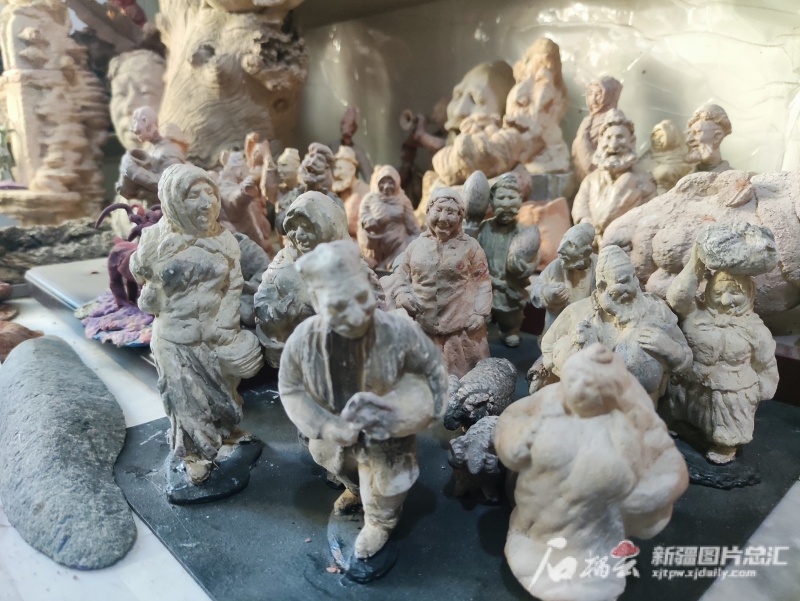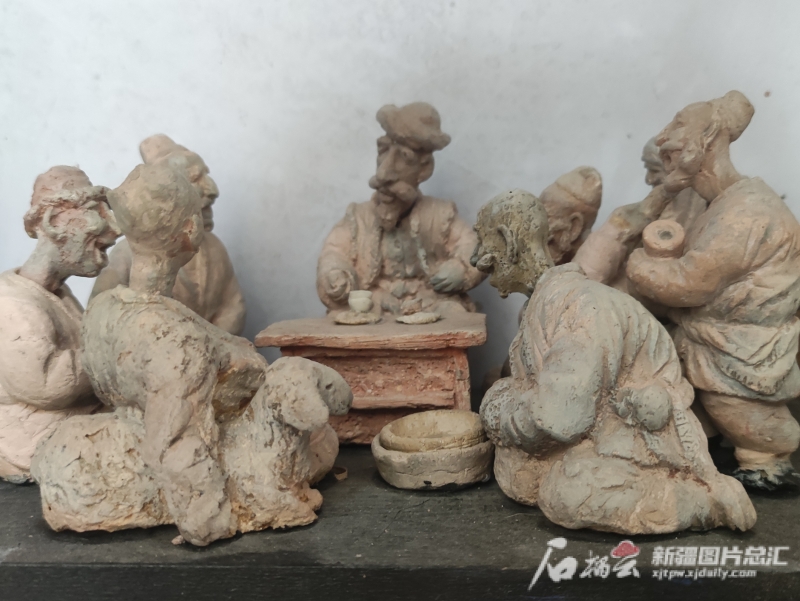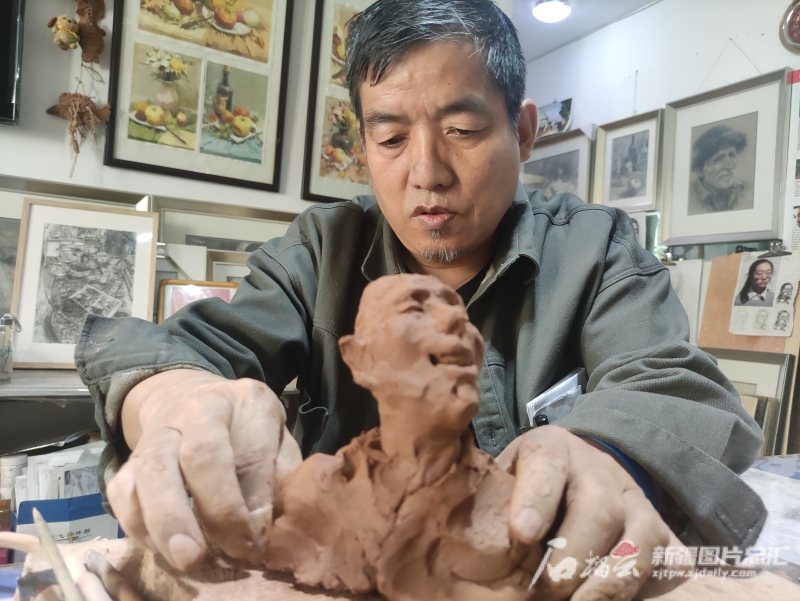Shiliuyun-Xinjiang Daily (Reporter Song Haibo) news: “Shaping a character's head is like doing addition and subtraction, one step more or less will change the image.” Clay in his hands was quickly twisted, gradually becoming a vivid character image. Wang Yong, who is making clay sculptures, is an autonomous region-level representative inheritor of the national-level intangible cultural heritage item, clay sculpture handicraft. He has been making clay sculptures for over forty years.

Photo shows clay sculptures in Wang Yong’s Clay Sculpture Studio. (Photo by Shiliuyun-Xinjiang Daily/ Song Haibo)
Walking into Wang Yong’s Clay Sculpture Studio in Guangming Road of Tianshan District, Urumqi City, northwest China’s Xinjiang Uygur Autonomous Region, you could enter a world of clay sculptures.

Photo shows clay sculptures in Wang Yong’s Clay Sculpture Studio. (Photo by Shiliuyun-Xinjiang Daily/ Song Haibo)
“I have been very interested in art since I was little. And in junior high school, I began to systematically learn sketching, color basics, and knowledge of human anatomy. After graduating from high school, Wang Yong was admitted to the School of Fine Arts at Xinjiang Normal University for further studies, injecting artistic thinking into his later clay sculpture creations. "In my spare time, I always take time to make clay sculptures. Once I start, it takes four or five hours.”

Photo shows Wang Yong makes clay sculpture in his studio. (Photo by Shiliuyun-Xinjiang Daily/ Song Haibo)
Making clay sculptures is not an easy work. From selecting materials to pretreatment and kneading mud, to fermentation, firing, and other processes, each step has its own details. In order to find the local customs and traditions of Xinjiang, Wang Yong travels throughout the year, not only observing local people’s lives, but also making clay sculptures with local soil. The soil in the Xishan mountains of Urumqi City is red mud, while the soil in the Gobi Desert of Qitai County has a high alkalinity. After firing, a layer of white crystal will appear on the surface of the clay sculpture, and the soil in Yengisar County is very delicate..." He carefully explained the characteristics of different soils and attempted to add ceramic particles to the soil to increase its hardness, creating a different type of work.
Wang Yong thought that making clay sculptures did not require many tools. “The hand is the best tool, and the fingers are the most precise instruments, which can shape vivid clay sculptures.” He can make many kinds of clay sculptures, including relief sculpture, and even hollowed-out sculptures, which shows the diversity and innovation of clay sculpture. The biggest feature of clay sculpture is that you can change the demeanor of characters according to different scenes and atmospheres.

Photo shows clay sculptures in Wang Yong’s Clay Sculpture Studio. (Photo by Shiliuyun-Xinjiang Daily/ Song Haibo)
“Every time I create a clay sculpture, I try to integrate the spirit of freehand brushwork in traditional Chinese painting into it.” Wang Yong shared his creative philosophy, and he doesn't always strive for perfect reproduction, which is the aesthetic essence of Chinese painting that does not seek similarity in form.
The Twelve Muqams and series of works Bazaar are my favorite works, and when shaping them, I try to combine fine brushwork and freehand brushwork.” Each character and the lively scene made by Wang Yong are vivid.
Wang Yong's clay sculptures have been widely recognized by people. His work, Go to Bazaar, was selected for the 10th National Art Exhibition Sculpture Exhibition and was collected by the Changchun Sculpture Art Museum. His series of works, Bazaar 1-18, Twelve Muqams, and Daolang Muqams, won the National Arts and Crafts Excellent Creation Award. He has also made clay sculptures for the Shaya County Museum, Hami Museum, Kashgar Museum, and other museums, showcasing the culture of Xinjiang.
In Wang Yong's studio, there are children learning clay sculpture. Jiang Wanrong, a primary school student who has been studying clay sculpture for two years, said, "Now I can make a clay cat in half an hour. Through learning clay sculpture, I can get more art knowledge." Tayir, a junior school freshmen, said: "I want to create clay sculptures based on my classmates." Wang Yong is also committed to making more people understand and learn clay sculpture through livestreaming.
Wang Yong looked at these works and said, "I want to showcase the charm of this land and the kind people of Xinjiang, letting people have a deeper understanding of the beautiful Xinjiang through these works.
(A written permission shall be obtained for reprinting, excerpting, copying and mirroring of the contents published on this website. Unauthorized aforementioned act shall be deemed an infringement, of which the actor shall be held accountable under the law.)









